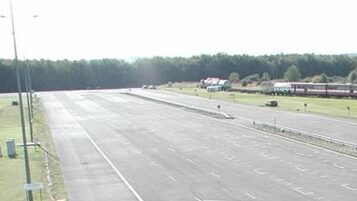Though there are one or two other contenders, the M96 very probably ranks as Britain’s shortest at 400 yards and most ethereal stretch of motorway – and if by chance it doesn’t actually hold both those records, its certainly unique in other ways.
For a start, its assuredly not where self-respecting sat-nav or road atlas junkies would instantly place it – and anyway no sat-nav or paper map shows it: yet the M96 is firmly in Gloucestershire, in the West country, in Gloucestershire. As those with an anorak-level interest in such arcane matters will know, Scotland is definitely where the M96 should be – under the formal road numbering system long used north of the border.
For the uninitiated, here’s a quick resumé of the reason why. Scotland’s motorway numbering system is relatively simple, and completely unrelated to the very much less comprehensible system used elsewhere on the British mainland. Perhaps we’ll have a shot at unravelling the complexities of the British motorway numbering system after devolution, and complex it certainly is…
Anyway, conveniently for Scotland, the England and Wales “A” road primary route numbering system was originally radially organised, and reached only as far as the A6. This allowed the A7, A8 and A9 to become Scotland’s primary roads. Later, that country’s motorways were built as far as possible by following the line of (and in some cases actually on the line of) any existing road which officialdom decided could benefit from major upgrading or capacity improvement. Such motorways then gained the same number as the existing or replaced A road, unsurprisingly preceded by the letter “M.”
This system worked well for Scotland up to a point, though some anomalies have inevitably arisen – which don’t really concern us here. Thus the M8 and A8 , the M9 and parts of the A9 are very close relatives, while the M74 replaced the A74 (and confusingly joins the British M6 at the Scottish border.) The mysterious Gloucestershire M96 might just possibly one day become a potential inconvenience to the Scots, since a genuine A96 does exist, running the scenic route from Aberdeen to Inverness. However given the terrain and distance involved, and the laughable state of road funding today, worries about any clash resulting from a motorway upgrade on this route any time soon are probably slightly premature.

So why exactly is the M96 residing in Gloucestershire – when the north of Scotland is its ancestral and rightful home? This orphan motorway is special indeed – its only around a mile long, and engineered to an asymmetric design, allowing more lanes in one direction than in the other. Its very low profile, it doesn’t go anywhere, and the best bit is – the public can’t see it, or even drive along it. Its hidden away at the Fire Service Training college at Moreton in the Marsh, Gloucestershire, where its primarily used to train emergency service personnel to deal with the many and various minor to very major incidents that occur on motorways.
The College itself is a world class training operation with a comprehensive range of on-site facilities embracing everything from ships to aircraft – so a full motorway set-up, but without the pressures of endless passing traffic, forms a pretty effective teaching aid. Thus the M96 was intendedset up as a full-scale simulation, kitted out to be as real as possible, with familiar motorway details, including typical blue signs, coloured cats eyes, emergency telephones and so on. Its use has extended beyond training – its also said to have appeared in films and on TV. Reputedly it had a starring role in the 2003 BBC drama ‘The day Britain Stopped,’ though I’m advised it was then credited as the M91, presumably to throw the great British public off the scent.
The M96 carriageway has the distinction of being laid out on what was originally a main runway of RAF Moreton in the Marsh, which until 1951 was an operational World War II unit of Bomber Command, used to train Wellington Bomber crews.
With that distinction comes an eerie and again probably unique coincidence, for also in Gloucestershire there’s an operational motorway carriageway with foundations built on more than a mile of the main runway from another long-disappeared wartime airfield. This one never hosted Wellingtons though, some even more historic (and highly significant) military aircraft departed from it. But that’s another story, to be found in another episode in this series.
If you’d like to know more about the M96 motorway enigma and the history of its location at Moreton in the Marsh, have a look at these sites:
www.wellingtonaviation.org/history/docs/index.htm
www.pathetic.org.uk/secretive/m96/
Dave Moss has a lifetime connection with the world of motoring. His father was a time-served skilled engineer from an age when car repairs really meant repairs: he ran his own garage from the 1930's to the 60's, while Mum was the boss's secretary at a big Austin distributor. Both worked their entire lives in the motor trade, so if motor oil's not in Dave's blood, its surely a very close thing.
Though qualified in Electronics, for Dave it seemed a natural step into restoring a succession of classic cars, culminating in a variety of Minis. Writing and broadcasting about these, and a widening range of motoring matters ancient and modern, gathered pace in the 1970's and has taken over since. Topics nowadays range across the modern motoring mainstream to the offbeat and more arcane aspects of motoring history, and outlets embrace books, websites national and international magazines, newspapers, radio programmes, phone-ins and guest appearances. Spare time: hard graft on the garage floor attending to vehicles old and new. Latest projects: that 1968 Mini Cooper S has finally moved again after 30 years, and when the paint is finished, the 1960 Morris Mini 850 will also soon be ready for the road again...

